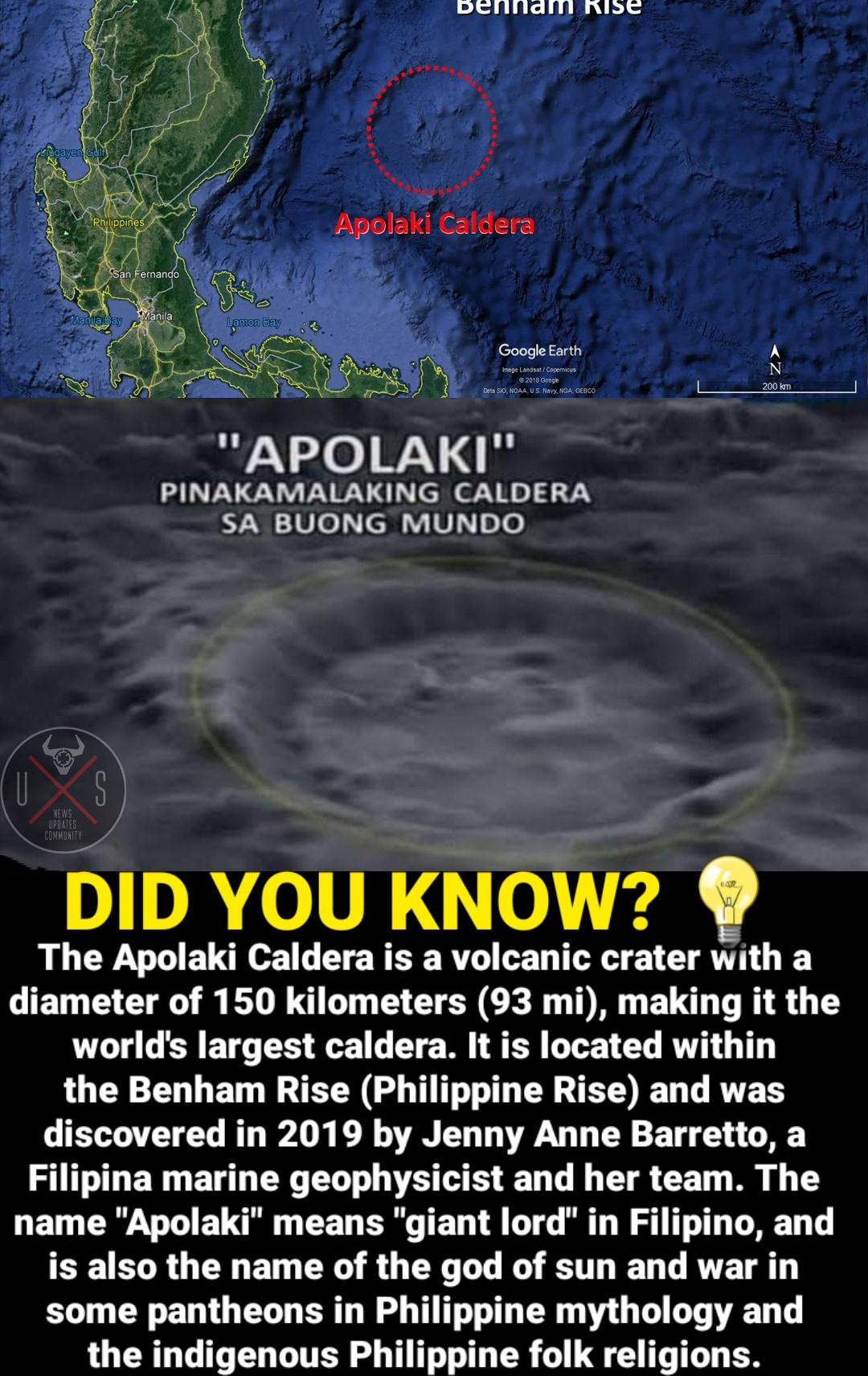Beneath the vast expanse of the Philippine Sea, scientists have uncovered what may be one of the largest calderas on Earth, the Apolaki Caldera. Named after Apolaki, the Filipino god of the sun and war, this colossal formation is a silent reminder of the country’s fiery geological past and its deep connection to the forces that shape our planet.
🌏 A Discovery Hidden in Plain Sight
The Apolaki Caldera was discovered by Filipino marine geophysicist Jenny Anne Barretto and her team in 2019, while they were studying the Benham Rise, officially known as the Philippine Rise. Using detailed seabed mapping, they found a circular depression roughly 150 kilometers (93 miles) wide, dwarfing even some of the world’s most famous volcanic structures.
This discovery stunned scientists worldwide. To put it into perspective, Apolaki is larger than Yellowstone Caldera in the United States and comparable in size to the Olympus Mons caldera on Mars, making it a true geological marvel hidden beneath Philippine waters.
🔥 The Giant That Slept for Millions of Years
The caldera lies within the Benham Rise, an undersea plateau believed to have formed from volcanic activity about 48 to 26 million years ago. Apolaki’s massive size suggests it was born from catastrophic volcanic eruptions, followed by the collapse of a giant magma chamber beneath the sea floor.
Over millions of years, the forces that once shaped it have grown quiet. Today, Apolaki rests deep under the ocean, its features preserved in silence, a sleeping giant that holds the secrets of the Earth’s fiery past.
🌋 A Source of National Pride and Scientific Curiosity
Beyond its scientific importance, the Apolaki Caldera has become a symbol of Filipino scientific achievement. It highlights the country’s role in global geology and showcases the talent of Filipino researchers in uncovering the mysteries of the deep sea.
Its discovery also underscores the strategic and environmental importance of the Philippine Rise, a resource-rich area that continues to attract attention for both research and conservation efforts.
⚠️ What Lies Beneath
While Apolaki is considered geologically inactive, it serves as a powerful reminder of the Philippines’ dynamic tectonic setting. The country sits on multiple converging plates, surrounded by trenches, faults, and volcanic arcs, all part of the Pacific Ring of Fire.
Understanding formations like Apolaki helps scientists trace the region’s ancient volcanic activity, predict future geological behavior, and protect communities from related hazards.
🌞 The Legacy of Apolaki
In Philippine mythology, Apolaki is the god who brings light to the world. Similarly, the discovery of the Apolaki Caldera has illuminated the nation’s scientific potential and deepened our understanding of the natural world.
Beneath the calm waves of the Philippine Sea lies a monumental story, one that blends science, national pride, and the enduring wonder of discovery.
⚠️ Readiness for Any Eventuality: If Apolaki Caldera Comes to Life
While current scientific evidence shows that the Apolaki Caldera is dormant, its sheer size and volcanic origin remind us that the Philippines is never far from geologic activity. Even long-quiet systems can awaken after millions of years under the right tectonic conditions, a reality that should inspire vigilance, not fear.
🔬 Understanding the Possibilities
If the Apolaki Caldera were ever to show signs of reactivation, the implications could be massive. The formation of such a large caldera suggests past eruptions of unimaginable scale. While this is considered highly unlikely in the near future, scientists emphasize the importance of continued monitoring through seismic studies and oceanographic research around the Philippine Rise.
By investing in geoscientific research, the Philippines can stay ahead of potential natural events and strengthen disaster preparedness for the entire region.
🧭 National Preparedness: What Can Be Done
Readiness for such large-scale events begins long before danger appears.
Here’s how preparedness can be strengthened:
- 🛰️ Expand Monitoring Networks – Increase oceanic and seismic sensors in and around the Philippine Rise to detect early geological changes.
- 🏫 Public Awareness Education – Inform communities about volcanic and tectonic systems in the country through schools, media, and local drills.
- 🧩 Inter-Agency Coordination – Strengthen partnerships among PHIVOLCS, NAMRIA, and academic institutions for continuous data sharing and hazard mapping.
- 🧱 Resilient Infrastructure Planning – Incorporate geological hazard assessments into future development plans in Eastern Luzon and nearby coastal areas.
💪 The Spirit of Readiness
The discovery of Apolaki is not a reason for fear, it’s a reminder of the power of knowledge and preparation. The Philippines, as part of the Pacific Ring of Fire, has always lived with the dynamic forces of the Earth.
By understanding these natural systems and preparing for any eventuality, we protect not only our people but also our heritage and the generations to come.
📖 Read for more about Disaster and Earthquake Articles


Leave a Reply